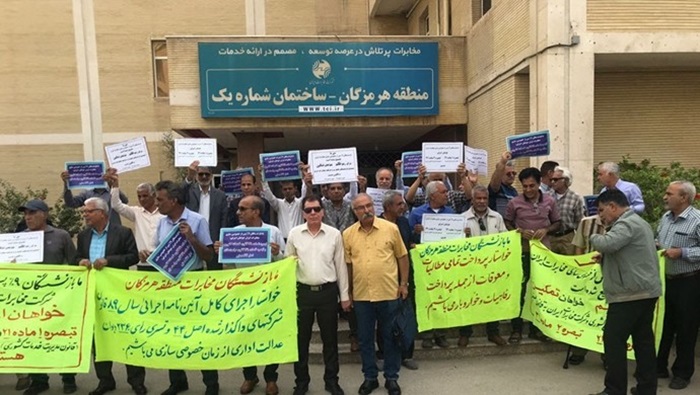

This wave of demonstrations, stretching from Arak to Tehran and Bandar Abbas to Tabriz, underscores a broader struggle against economic injustice and the worsening living conditions faced by Iran’s retired workforce.
In the capital city of Tehran, retirees organized a significant protest and march along Sardar Jangal Boulevard, voicing their frustrations and demands for attention to their dire situation. This scene of discontent was mirrored in cities like Khorramabad, Shiraz, and Qorveh, where retirees and other groups rallied to express their demands, signaling a nationwide outcry for reform.
March 4—Khorram Abad, western #Iran
Retirees and pensioners of the Telecommunications Company of Iran rally to protest low pensions and poor living conditions.#IranProtestspic.twitter.com/fC5UHQLZ9Q— People's Mojahedin Organization of Iran (PMOI/MEK) (@Mojahedineng) March 4, 2024
A notable grievance among the protesters in Tabriz centered on the government’s failure to implement a law passed in 2010, which mandates the adjustment of retirement pensions in line with living costs. This law, aimed at securing the economic stability of retirees amidst spiraling inflation and rising living costs, remains largely ignored, exacerbating the plight of those it intended to protect.
In Ahvaz, chants of “Unite against tyranny and corruption” echoed the collective frustration toward the government’s inability to bridge the economic disparities plaguing retirees. This sentiment is shared widely across the country, with demonstrators in Kermanshah rallying against the regime’s disregard for laws requiring pension adjustments based on living costs.
March 4—Tehran, #Iran
Retired employees of the Telecommunications Company of Iran resume protest rallies, demanding the implementation of a law requiring the government to adjust their pensions according to the costs of living.#IranProtestspic.twitter.com/s0fIZpdoOV— People's Mojahedin Organization of Iran (PMOI/MEK) (@Mojahedineng) March 4, 2024
The protests are a culmination of over a decade of governmental neglect, with retirees’ conditions deteriorating as the cost of basic goods rises while pensions remain stagnant. This economic gap has not only pushed retirees but also workers from various sectors to the brink, leading to a series of strikes and protest marches across Iran.
Nurses in Shiraz, technical staff in Chabahar, industrial workers in Kashan, and petrochemical employees in Dehdasht have all raised their voices against poor working conditions, unpaid wages, and unmet demands, signaling widespread discontent with the state of labor and economic justice in the country.
February 12—Sanandaj, western #Iran
Retirees of the Telecommunications Company of Iran rally, protesting the regime disregarding its own laws that require the TCI to raise the retirees' pensions according to the costs of living.#IranProtestspic.twitter.com/ispvAFl9mT— People's Mojahedin Organization of Iran (PMOI/MEK) (@Mojahedineng) February 12, 2024
These demonstrations, coinciding with the aftermath of the regime’s parliamentary elections, highlight a growing disillusionment among the Iranian populace with the government’s role in their lives.
Despite changes in the Majlis or Presidential palace, the people of Iran recognize that their voices in the streets are their most potent tools in the fight for their rights. As protests continue, the call for fundamental reforms grows louder, not just from retirees but from workers across various industries, united in their demand for economic justice and a government that addresses their needs and rights.
March 4—Chabahar, southeast #Iran
Technical and engineering staff of Chabahar water pumping station hold protest rally as authorities refrain from paying their overdue wages and address their basic demands.#IranProtestspic.twitter.com/jG3skEBMgS— People's Mojahedin Organization of Iran (PMOI/MEK) (@Mojahedineng) March 4, 2024
This nationwide movement underscores a critical moment for Iran, as its citizens increasingly seek to hold their leaders accountable for the country’s economic disparities and the deteriorating conditions of its workforce.

MEK Iran (follow us on Twitter and Facebook), Maryam Rajavi’s on her site, Twitter & Facebook, NCRI (Twitter & Facebook), and People’s Mojahedin Organization of Iran – MEK IRAN – YouTu







